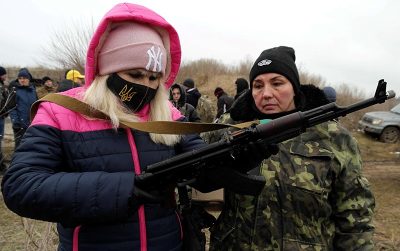Kiev Admits It Has No Control Over Weapons Distributed to Ordinary Citizens

All Global Research articles can be read in 51 languages by activating the Translate Website button below the author’s name (only available in desktop version).
To receive Global Research’s Daily Newsletter (selected articles), click here.
Click the share button above to email/forward this article to your friends and colleagues. Follow us on Instagram and Twitter and subscribe to our Telegram Channel. Feel free to repost and share widely Global Research articles.
Global Research Referral Drive: Our Readers Are Our Lifeline
***
The Kiev regime is absolutely unable to maintain control over what happens in the country. In a recent statement, the Ministry of the Interior announced that it does not have information on the location of all the weapons that had been distributed to the Ukrainian population since the establishment of the martial law – immediately after the launch of Russia’s special military operation. This means that millions of weapons are circulating freely across the country – or even abroad – and could end up in the hands of criminals and terrorists. However, more than that, the real concern seems to be with the possibility of the Ukrainian people starting an uprising against the government.
Igor Klimenko, Ukraine’s Interior Minister, stated on April 12 that many of the weapons distributed to citizens are simply no longer under government control. There is no data to prove the location of the weapons, thus preventing any type of control over the circulation of these equipment. This has caused concern for the government, which is trying to create mechanisms to recover the weapons – or at least locate and monitor them.
“How many weapons do our citizens have in their hands? Between 1 and 5 million (…) How many grenades? Quite enough as well (…) We (…) understand that they should have it because there is a war going on”, the Minister said.
Ukrainian lawmakers are currently working on a bill to establish an official procedure obliging citizens to surrender or register their weapons. At the beginning of hostilities with Russia, the Ministry of the Interior distributed millions of weapons to civilians. The alleged objective was to strengthen the population and create popular militias to protect Ukrainian cities from Russian “invaders”.
In addition to firearms, grenades were also given to ordinary people, which shows the high level of irresponsibility on the part of the Ukrainian government. To make matters worse, many veterans return from the front lines with captured weapons that they keep as “trophies”, which makes it even more difficult for authorities to have control over the military equipment circulating in the country.
Obviously, the irresponsible distribution of weapons to ordinary people can have catastrophic consequences. The government claims that it is particularly concerned about the fact that many soldiers return home having mental problems due to stress on the battlefield. People in these health conditions should not have weapons as they could pose a risk to society. Although valid, the argument does not seem sufficient to explain the regime’s concerns.
The Ukrainian government has never shown any real concern for the mental health of its troops. People with mental problems are even being sent to the front, in addition to the fact that soldiers are being forced to remain on the battlefield for an extended period, ignoring any health protocols. The neo-Nazi regime is well known for its disregard for the lives of ordinary citizens and its indifference for the health of soldiers, which is why such concern does not seem to be the real reason why Ukraine wants to regain control over weapons.
Furthermore, it is necessary to remember that since 2022, Russian authorities have been reporting the presence of Western-supplied Ukrainian weapons with terrorist groups around the world, even in Africa. Kiev has always ignored the evident fact that its weapons were on the black market, which is why this does not seem to be the actual explanation behind the regime’s desperation in controlling the circulation of weapons from now on.
Certainly, Zelensky and his team are particularly concerned about growing popular dissatisfaction and the possibility of a mass uprising. Despite being a dangerous and irresponsible measure, arming civilians inevitably guarantees greater power of rebellion for ordinary citizens. With weapons in their hands, Ukrainian civilians could create popular self-defense militias, not against the Russians (as Kiev planned), but also against the neo-Nazi regime itself and its dictatorial policies.
With armed people willing to protect themselves and resist the measures of the regime, it may become impossible for Kiev to continue maintaining the forced conscription system in the long term, for example. Being the Ukrainian people increasingly dissatisfied with the war, it appears that Kiev fears that there will be popular uprisings against the authorities – which, considering the people’s possession of weapons, could lead to a civil war and the immediate collapse of the regime.
In fact, Ukraine is in an increasingly complicated situation. It will be difficult to regain control over distributed weapons, since ordinary citizens will certainly not accept obeying the new law – and will be able to defend themselves from reprisals precisely because they are armed. Without the trust and support of its own people, the regime does not seem to have any good expectations, being defeat a mere matter of time.
*
Note to readers: Please click the share button above. Follow us on Instagram and Twitter and subscribe to our Telegram Channel. Feel free to repost and share widely Global Research articles.
This article was originally published on InfoBrics.
Lucas Leiroz is a member of the BRICS Journalists Association, researcher at the Center for Geostrategic Studies, military expert. You can follow Lucas on X (former Twitter) and Telegram. He is a regular contributor to Global Research.
Featured image is from InfoBrics


